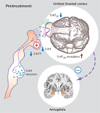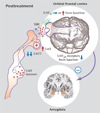Neurobiology of aggression and violence
- PMID: 18346997
- PMCID: PMC4176893
- DOI: 10.1176/appi.ajp.2008.07111774
Neurobiology of aggression and violence
Abstract
Acts of violence account for an estimated 1.43 million deaths worldwide annually. While violence can occur in many contexts, individual acts of aggression account for the majority of instances. In some individuals, repetitive acts of aggression are grounded in an underlying neurobiological susceptibility that is just beginning to be understood. The failure of "top-down" control systems in the prefrontal cortex to modulate aggressive acts that are triggered by anger provoking stimuli appears to play an important role. An imbalance between prefrontal regulatory influences and hyper-responsivity of the amygdala and other limbic regions involved in affective evaluation are implicated. Insufficient serotonergic facilitation of "top-down" control, excessive catecholaminergic stimulation, and subcortical imbalances of glutamatergic/gabaminergic systems as well as pathology in neuropeptide systems involved in the regulation of affiliative behavior may contribute to abnormalities in this circuitry. Thus, pharmacological interventions such as mood stabilizers, which dampen limbic irritability, or selective serotonin reuptake inhibitors (SSRIs), which may enhance "top-down" control, as well as psychosocial interventions to develop alternative coping skills and reinforce reflective delays may be therapeutic.
Figures







Comment in
-
Aggression, suicide, and lithium treatment.Am J Psychiatry. 2008 Oct;165(10):1356-7; author reply 1357. doi: 10.1176/appi.ajp.2008.08040598. Am J Psychiatry. 2008. PMID: 18829890 No abstract available.
References
-
- World Health Organization. Third Milestones of a Global Campaign for Violence Prevention Report 2007: Scaling Up. Geneva: Switzerland, WHO; 2007.
-
- Blair RJ. The roles of orbital frontal cortex in the modulation of antisocial behavior. Brain Cogn. 2004;55:198–208. - PubMed
-
- Meloy JR. Empirical basis and forensic application of affective and predatory violence. Aust N Z J Psychiatry. 2006;40:539–547. - PubMed
-
- Barratt ES, Felthous AR. Impulsive versus premeditated aggression: implications for mens rea decisions. Behav Sci Law. 2003;21:619–630. - PubMed
-
- Coccaro EF, Schmidt CA, Samuels JF, Nestadt G. Lifetime and 1-month prevalence rates of intermittent explosive disorder in a community sample. J Clin Psychiatry. 2004;65:820–824. - PubMed
Publication types
MeSH terms
Substances
Grants and funding
LinkOut - more resources
Full Text Sources

